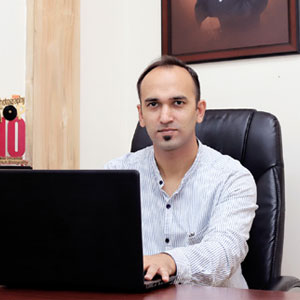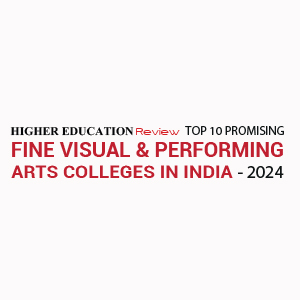
Symbiosis School Of Visual Arts & Photography: Fostering Industry-Ready Professionals Through Unique Educational Model
By Dr. Gagan Prakash, Director
The visual arts and photography landscape in India has transformed dramatically in recent years. Affordable data, spurred by Jio’s 2016 launch, revolutionized visual content consumption and significantly increased smartphone access. This surge forced the industry to evolve, blending traditional roles into versatile skill sets. Historically, distinct roles like photographers and videographers have now blurred, creating demand for professionals adept at capturing and editing various media. Technology and AI have further simplified these processes. The future of visual arts requires a holistic understanding of diverse visual forms, essential for preparing professionals for the expanding industry.
Symbiosis School of Photography, recognizing these industry shifts, transitioned into the Symbiosis School of Visual Arts and Photography (SSVAP) in 2018. This change reflects the broader vision of encompassing all visual art forms and responding to the evolving demands of the industry. The transformation was driven by the realization that photographers today are more than just photographers - they are visual artists creating diverse content across various formats. Also, the school's transition was influenced by industry trends and the need to stay relevant.
Traditional photography education, while foundational, was no longer sufficient. The integration of visual arts beyond photography was necessary to equip students with the skills required to excel in a multifaceted industry. This holistic approach aligns with the needs of the industry, which demands individuals skilled in multiple visual art forms.
SSVAP's inception was driven by a vision to create a comprehensive visual arts school in India, filling a niche that previously did not exist. “Although there are fine arts and visual communication schools, our institution seeks to combine aesthetics with commercial viability. Drawing inspiration from the European approach, our school merges art and aesthetics with business acumen, acknowledging the significance of comprehending the market and the commercial aspects of visual arts,” says Dr. Gagan Prakash, the Director of SSVAP.
One of the primary challenges for higher education institutes globally is preparing students for the industry. SSVAP addresses this through three main pillars: a forward-looking curriculum, industry-academia collaboration, and practical exposure through projects.
The curriculum is continually updated to reflect industry trends and technological advancements. Collaboration with the industry is a cornerstone of the school's approach, ensuring students gain vital hands-on experience through projects, workshops, and industry interactions, equipping them for future challenges.
Further, the collaboration between academics and industry involves projects, workshops, and exposure to industry practices. This interaction helps students understand industry requirements and prepares them for real-world scenarios. Practical exposure through compulsory industry projects from the second year onward ensures that students gain valuable experience and start earning early, motivating them and instilling professionalism.
SSVAP stands out as the only core visual arts school in India, offering a degree in visual arts. Unlike other schools that focus primarily on techniques and skills, SSVAP integrates art, aesthetics, and commercial understanding. This holistic approach ensures that students not only develop their artistic skills but also understand the business aspects of visual arts.
The school emphasizes the importance of content management alongside content creation, recognizing that managing visual content is as crucial as creating it. This comprehensive approach is essential in an industry where AI can assist with content creation, but original content and its management remain indispensable.
The quality of faculty is crucial for any educational institute. SSVAP ensures that its faculty comprises industry experts who bring practical experience to the classroom. With 60 percent of the courses taught by faculty from the industry, students gain insights from professionals actively working in the field. This industry connection enriches the learning experience and ensures that students are up-to-date with current industry practices. In addition, SSVAP provides state-of-the-art infrastructure to support hands-on training. Recognizing the financial barriers, the school offers scholarships and concessions to top-performing students, easing their entry into the visual arts space. The school also discourages first-year students from purchasing expensive equipment, providing necessary tools and support within the campus to ensure equitable learning opportunities.
”SSVAP is shaping the future of visual media education in India, ensuring that its graduates are versatile, skilled, and ready to lead in a rapidly evolving field”
Industry-academia partnerships are essential for aligning education with industry requirements. SSVAP collaborates with leading companies like Sony, ensuring access to the latest technology and research opportunities. This collaboration extends to internships and projects, facilitated by the school’s project cell, alumni network, and senior students, creating a robust support system for students.
Additionally, SSVAP encourages students to embrace AI as a tool rather than a threat. AI assists in automating routine tasks, but original content creation remains a human endeavour. By focusing on producing original content, students can leverage AI to enhance their work, rather than being intimidated by it.
Looking ahead, SSVAP aims to bridge the gap between academia and industry further, focusing on innovation and forward-looking curriculum development. The school is committed to being ahead of industry trends, ensuring that its graduates are well-prepared for future challenges.
In conclusion, SSVAP is at the forefront of visual arts education in India, responding to industry changes with a comprehensive, forward-looking approach. By integrating art, aesthetics, and commercial understanding, the school prepares students for a dynamic industry. With state-of-the-art infrastructure, industry collaborations, and a commitment to innovation, SSVAP is shaping the future of visual media education in India, ensuring that its graduates are versatile, skilled, and ready to lead in a rapidly evolving field.
Symbiosis School of Photography, recognizing these industry shifts, transitioned into the Symbiosis School of Visual Arts and Photography (SSVAP) in 2018. This change reflects the broader vision of encompassing all visual art forms and responding to the evolving demands of the industry. The transformation was driven by the realization that photographers today are more than just photographers - they are visual artists creating diverse content across various formats. Also, the school's transition was influenced by industry trends and the need to stay relevant.
Traditional photography education, while foundational, was no longer sufficient. The integration of visual arts beyond photography was necessary to equip students with the skills required to excel in a multifaceted industry. This holistic approach aligns with the needs of the industry, which demands individuals skilled in multiple visual art forms.
Inception & Vision
SSVAP's inception was driven by a vision to create a comprehensive visual arts school in India, filling a niche that previously did not exist. “Although there are fine arts and visual communication schools, our institution seeks to combine aesthetics with commercial viability. Drawing inspiration from the European approach, our school merges art and aesthetics with business acumen, acknowledging the significance of comprehending the market and the commercial aspects of visual arts,” says Dr. Gagan Prakash, the Director of SSVAP.
One of the primary challenges for higher education institutes globally is preparing students for the industry. SSVAP addresses this through three main pillars: a forward-looking curriculum, industry-academia collaboration, and practical exposure through projects.
The curriculum is continually updated to reflect industry trends and technological advancements. Collaboration with the industry is a cornerstone of the school's approach, ensuring students gain vital hands-on experience through projects, workshops, and industry interactions, equipping them for future challenges.
Further, the collaboration between academics and industry involves projects, workshops, and exposure to industry practices. This interaction helps students understand industry requirements and prepares them for real-world scenarios. Practical exposure through compulsory industry projects from the second year onward ensures that students gain valuable experience and start earning early, motivating them and instilling professionalism.
Practical Exposure Through Industry Professionals
SSVAP stands out as the only core visual arts school in India, offering a degree in visual arts. Unlike other schools that focus primarily on techniques and skills, SSVAP integrates art, aesthetics, and commercial understanding. This holistic approach ensures that students not only develop their artistic skills but also understand the business aspects of visual arts.
The school emphasizes the importance of content management alongside content creation, recognizing that managing visual content is as crucial as creating it. This comprehensive approach is essential in an industry where AI can assist with content creation, but original content and its management remain indispensable.
The quality of faculty is crucial for any educational institute. SSVAP ensures that its faculty comprises industry experts who bring practical experience to the classroom. With 60 percent of the courses taught by faculty from the industry, students gain insights from professionals actively working in the field. This industry connection enriches the learning experience and ensures that students are up-to-date with current industry practices. In addition, SSVAP provides state-of-the-art infrastructure to support hands-on training. Recognizing the financial barriers, the school offers scholarships and concessions to top-performing students, easing their entry into the visual arts space. The school also discourages first-year students from purchasing expensive equipment, providing necessary tools and support within the campus to ensure equitable learning opportunities.
”SSVAP is shaping the future of visual media education in India, ensuring that its graduates are versatile, skilled, and ready to lead in a rapidly evolving field”
Industry-Academia Partnerships & Future Roadmap
Industry-academia partnerships are essential for aligning education with industry requirements. SSVAP collaborates with leading companies like Sony, ensuring access to the latest technology and research opportunities. This collaboration extends to internships and projects, facilitated by the school’s project cell, alumni network, and senior students, creating a robust support system for students.
Additionally, SSVAP encourages students to embrace AI as a tool rather than a threat. AI assists in automating routine tasks, but original content creation remains a human endeavour. By focusing on producing original content, students can leverage AI to enhance their work, rather than being intimidated by it.
Looking ahead, SSVAP aims to bridge the gap between academia and industry further, focusing on innovation and forward-looking curriculum development. The school is committed to being ahead of industry trends, ensuring that its graduates are well-prepared for future challenges.
In conclusion, SSVAP is at the forefront of visual arts education in India, responding to industry changes with a comprehensive, forward-looking approach. By integrating art, aesthetics, and commercial understanding, the school prepares students for a dynamic industry. With state-of-the-art infrastructure, industry collaborations, and a commitment to innovation, SSVAP is shaping the future of visual media education in India, ensuring that its graduates are versatile, skilled, and ready to lead in a rapidly evolving field.


